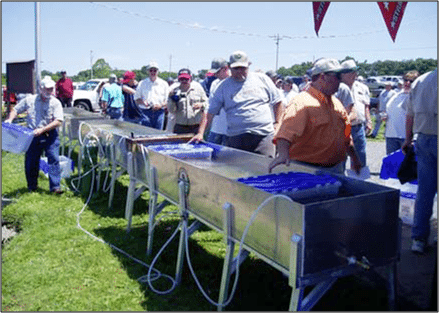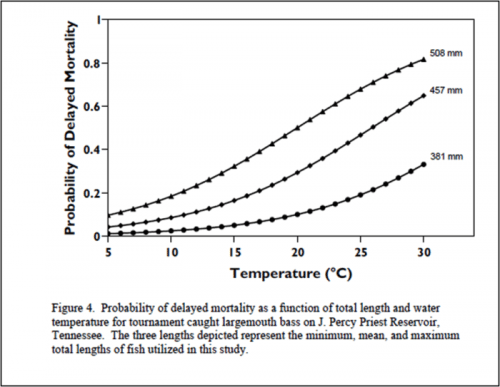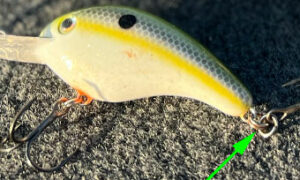 It’s at the core of every bass tournament. Yes, the fishing is important, and the personalities are entertaining, but a winner is never declared until the fish have made their way to the scales. How that weigh-in occurs, as well as how the fish are handled up to that event, has slowly been changing over the years. Gone are the days of stringered bass in an event. The “catch-and-release” ethic has been an overwhelming success by most any measurement in the bassin’ community. Livewells have improved, oxygenation systems have been making more headway into the sport, and the number of bass which constitutes a “limit” that can be weighed has continued to drop, to the point where 5 bass is a generally accepted standard throughout much of the country.
It’s at the core of every bass tournament. Yes, the fishing is important, and the personalities are entertaining, but a winner is never declared until the fish have made their way to the scales. How that weigh-in occurs, as well as how the fish are handled up to that event, has slowly been changing over the years. Gone are the days of stringered bass in an event. The “catch-and-release” ethic has been an overwhelming success by most any measurement in the bassin’ community. Livewells have improved, oxygenation systems have been making more headway into the sport, and the number of bass which constitutes a “limit” that can be weighed has continued to drop, to the point where 5 bass is a generally accepted standard throughout much of the country.
Science has played at least a background role in driving a lot of this change. One area where that is most obvious has been the advent of the “water weigh-in.” It’s caught on in some of the larger Canadian circuits, and here in the U.S., the most prominent case has been its use at certain times in some of the higher ranks of the FLW Outdoors circuits, including select bass and walleye events. There’s been some interesting research around this and other related topics in the bass world, and not all of it has come to the same conclusion. Let’s look at some of it.
The initial driver for the development of the water weigh-in was based on research by Cori Suski and team out of Queen’s University that was published in 2003. They found significant differences in the amount of physiological disturbances to bass going through the traditional weigh-in process vs. controls. Their research was partly supported by Shimano, Canada, Ltd., and ultimately resulted in what is now commonly referred to as the “Shimano Water Weigh-in System”. A quote from the original research paper gives the basis behind this systems development.
“…Strategies to ensure that sufficient oxygenation is constantly provided in areas such as live wells, weigh-in bags, holding tanks, and release vessels and to minimize the periods of air exposure during the weigh-in should be viewed as extremely important, as they would probably reduce the magnitude of this metabolic disturbance. Effective strategies that minimize the magnitude of this disturbance would also probably reduce the overall stress levels in bass, and, in turn, fish mortality and other potentially important sublethal impacts of stress (Barton and Iwama 1991) that may arise from these events.”
The core benefit of the water weigh-in system is to minimize a bass’s exposure to air throughout the entire weigh-in process, thereby purportedly limiting stress factors that might contribute to delayed recovery, or even mortality. A secondary benefit is the possible increased accuracy of the technique, which eliminates any “flopping around” of a fish being weighed on the scale. Lastly, there can be argued a perception benefit to the public when they see the bass “swimming” in the water tank on the scale during the event.
Now, the other side of the coin. Following up on that research several years later (2007) in a report to the Tennessee Wildlife Resources Agency, Jamison, Bettoli and Redding from Tennessee Tech evaluated a series of tournaments on J. Percy Priest Reservoir throughout the course of the year, and encompassing a wide range of both water temperatures and bass sizes. Their primary objective was to compare water weigh-ins to the more common “in the bag” weighing format “in the field”. Interestingly, they found very little differences in blood lactate and cortisol concentrations, and minimal effects on plasma osmolarity. The biggest finding though, was that they reported no differences in the level of delayed mortality in tournament-caught-and-released largemouth bass between the two systems, all of which were radio tracked as opposed to being held in a net or penned holding conditions.
One of the more relevant findings from the Tennessee study was this chart showing baseline mortality of tournament caught bass as it relates to water temperatures and fish size.
This study’s findings bring up some interesting questions, then. Is there perhaps a regional or latitudinal difference in a basses ability to deal with stress? Are small bass more likely to experience stress than larger bass? If there is truly no difference in delayed mortality between the two techniques, does the perception benefit of water weigh-ins outweigh the ease and established protocol/physical resources of a traditional weigh-in? And is there a case to be made to not hold summer tournaments (July-August) due to the likelihood of much higher baseline mortalities?
I’m not certain what any of the answers are, or exactly where we go from here, but I would be curious to know what the standard weigh-in procedure is currently in your state tourneys. Also, have you ever been a part of a water weigh-in event and what are your thoughts related to such – like or disliked? Do you think things are just fine as they currently stand, or do we need to continue to push for further improvements in fish handling and weigh-in procedures? Good science isn’t emotional or biased, it merely supplies the data, and as we like to say, the data “is what it is”. It’s up to us to decide how we choose, or even whether we choose, to act on it.
For further information, you can read both research papers at the following links:
Physiology and survival of tournament-caught largemouth bass





























Chad Keogh
March 7, 2011 at 8:36 am
There is no denying that tournaments have come a long way when it comes to fish handling and the mortality rates of released bass. However, I think with the modern technology we have today, we should push further.
Right now, most live weigh-in events say they have 2-5% mortality rates (both immediate and delayed). So if you have a 100 angler field and they all catch limits, that’s 500 total bass caught. And if let’s say 3% die, that’s 15 bass dead.
Doesn’t sound like a lot of bass, and of course, if we wanted to it would be completely legal to kill and eat all 500. But that’s not the point.
Chances are good that the 15 dead bass were big bass since the bigger that bass, the more stress it feels from being confined for long periods of time. Depending on where the tournament is held, it may have taken 10-20 years for the bass to get that big, and it will take that long to replace them.
What I have suggested is more along the lines of the AIM tournament series in the Northern USA. Catch, weigh, measure, photo, IMMEDIATE release. Then at the end of the tournament, they download your photos, and show your biggest five on a large background screen.
With that format, the only bass that would possibly die would be if they were hooked deep in the stomach, or taken up quickly from deep water and not fizzed. Both of which are very unlikely since tournament anglers usually use very sensitive rods which would minimize deep hooking, and they mostly know when and how to fizz a bass.
What if Ray Scott thought, “Why change the way we are doing things?” back in the ’70s when he implemented Don’t Kill Your Catch?
melvin jennings
March 7, 2011 at 9:54 am
I understand the major tournament circuits get a bonus from a sponsor/sponsors if mortality is kept at 2% or lower. What has always concerned me is what “they” determine as a dead fish.
Many times I have seen floating bass after release that are obviously dead, but were called alive at weigh-in i.e. if any part of fish moves, it is alive. Also at regional tournaments I have fished, the determination of live or dead is made at the lake BEFORE trailering the boat 10,15 or more miles to weigh-in site.
In short, I think mortality rate as provided by Tournament organizers is skewed in their favor and not a reflection of reality.
Jacob Robinson
March 7, 2011 at 1:17 pm
If everyone adopted the method of “catch, photo, release”, fishing would lose most of its spectators. People love going to the weigh-ins.
Jason
March 7, 2011 at 3:46 pm
I agree with the spectator aspect, but something I’ve been pondering lately is the idea of catch, VIDEO, release.
You can get an HD-capable waterproof video camera like a Kodak Playspot or GoPro for less than $200 these days. You can also get creative with hatcams or the sunglasses with the cameras in them.
I think catch, video, release might have a lot more appeal than catch/photo. We’d get to see first-person footage of the guys actually on the water catching, measuring and weighing fish. Think about the angler coming up on stage and doing an interview while video of his catches and weights played in the background. A little editing could make for a pretty dramatic “weigh-in”.
Bass Pundit
March 8, 2011 at 2:05 am
One of the biggest problems with this suggestion is the problem of doing prompt and quality editing. For it to work you would probably have to have amatuer camera men, doing most if not all of the work in the immediate aftermath of the action happening.
We are not there yet and I’m not sure how close or realistic this may be.
Jesse Hall
March 10, 2011 at 8:30 pm
I’m not sure water weigh-in are necessarily the way to go, but I do certainly think that tournament directors need to be more aware of the procedures of getting fish to the scales, as do the fishermen. There are numerous things we can all do to keep stress levels down on the fish and keep them in a more comfortable environment while spending the day in a livewell. We have got remember, the more fish we save, the more fish in the lake. The more fish in the lake, the more we catch. The more we catch, the more tourneys we win and the more fun we will have. Without the fish, the sport of bass fishing doesn’t even exist.